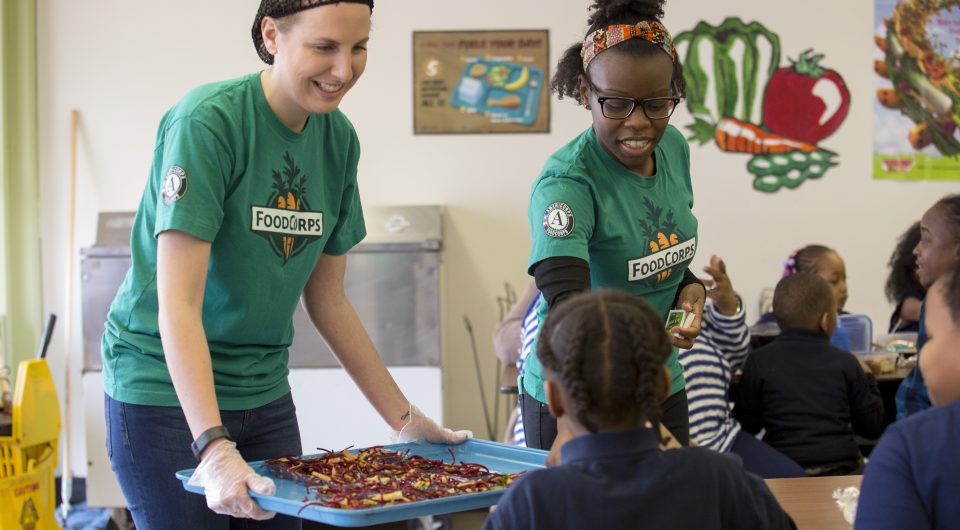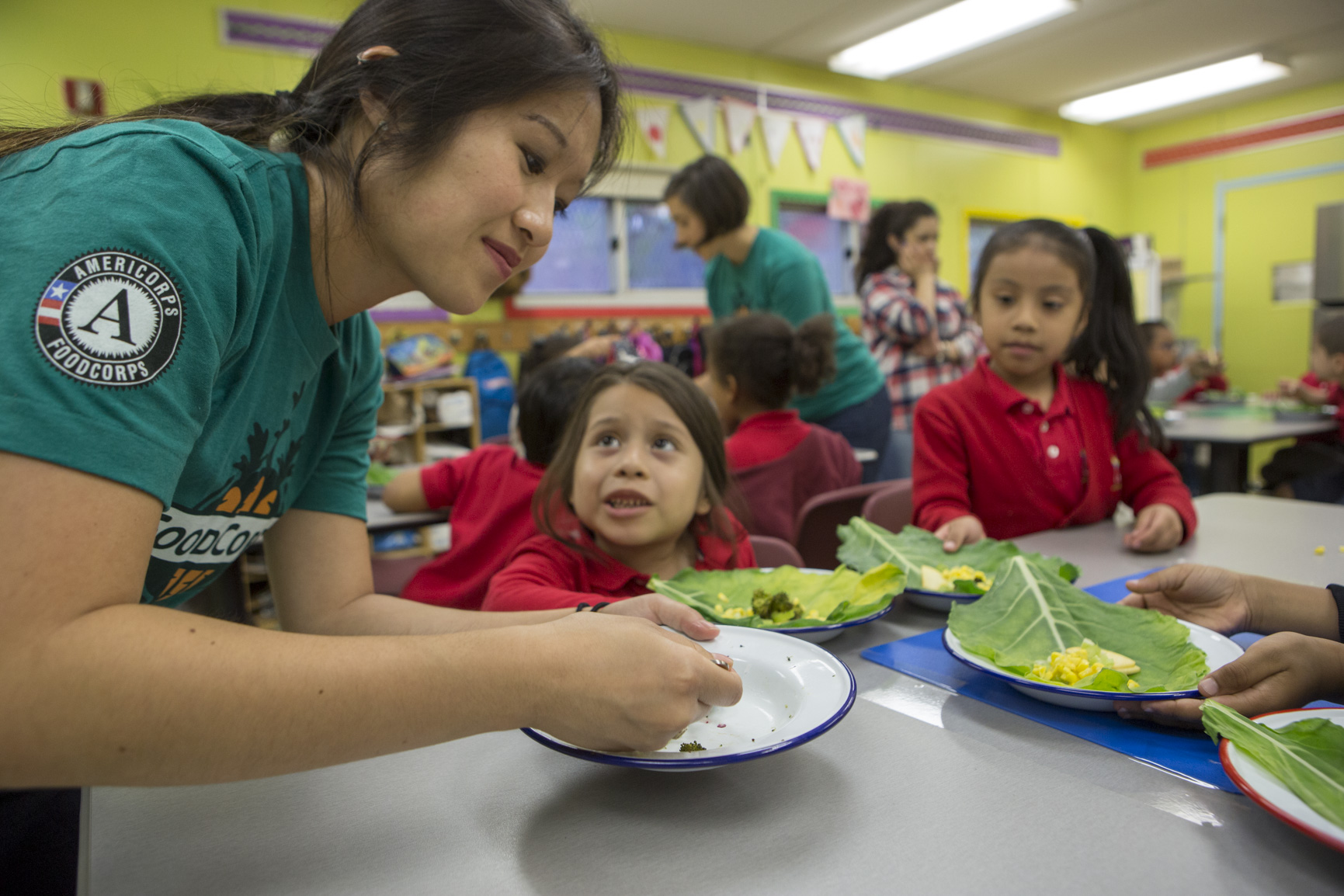
Thanks to the persistence of social entrepreneurs across the country, every day we see strategies that are working and delivering results in a rapidly changing world. This Evidence in Action blog series highlights the voices of the more than 70 social innovation organizations that make up the America Forward Coalition, the results-driven solutions our community has to our country’s most pressing social problems, and the evidence-based federal programs that are critical to scaling the impact of this work. Today we will hear from Stella Doughty, Government Partnerships Coordinator with Coalition organization FoodCorps, about the evidence-based strategies FoodCorps uses to make schools healthier.
It was often the smallest moments that would fill me up and remind me that my work as a FoodCorps service member mattered, that together with my school community, we really were making progress towards a healthier school food environment. These small moments — little pieces of evidence that things were shifting— are extremely gratifying, and often very cute, too. A first-grade student tugging at my shirt for my attention repeatedly and gleefully exclaiming “I love the salad! I love the salad!” or a young boy proudly displaying his wiped-clean salad bar plate wondering “when does the clean plate club meet?” When that notoriously stubborn eater who I prodded to try just one bite of broccoli day after day finally relented and took not one bite but two—and her friend did, too. These little moments are accompanied by other shifts, too. A teacher noticing that her student who usually struggles to focus is actively engaged during garden class. Students’ parents asking for the recipe I made with their child in class (they want to make it at home for dinner). My school’s food service director wondering if I could run a taste test with asparagus because they’ll have it on the lunch line next week. As a service member, these small and incremental shifts feel like enormous wins because, taken together, they are. Across the country, this year in over 360 schools in 17 states and Washington, D.C., FoodCorps service members are the catalysts for these same shifts toward healthy school food environments.
I witnessed those shifts first hand as a FoodCorps service member. Now as a staff member working on government and strategic partnerships, I get to see how we are measuring those shifts across all of the 350 schools we serve. I get to see and work with real data that reinforces those stories I lived every day in my school. It’s very exciting to see the results of the various evaluations we run each year.

FoodCorps connects kids to healthy food in school. Our team of AmeriCorps leaders serve in high-need schools to make sure students learn what healthy food is, fall in love with it, and eat it every day. As the places where children spend a third of their day and often eat at least half their calories, schools are a primary driver in young people’s knowledge of, attitudes about, and access to food. Therefore, schools, particularly in communities that suffer elevated inequities in public health, income, and education, are a critical point of intervention against diet-related disease. Only when our schools are places where students learn what a healthy diet is, establish a connection to the farms and soils where food is grown, and eat nutritious meals every day will our children be set up to thrive.
In order to make sure that our program is working, we designed it to focus on three evidence-based strategies that get children eating healthy:
- Hands-on learning: Students grow, cook, and taste new foods, which builds their skills and changes food preferences.
- Healthy school meals: The cafeteria experience steers students toward the healthiest options and gets them excited to try new healthy foods.
- A schoolwide culture of health: As a whole, the school community and environment – from hallways to classrooms to cafeteria to grounds – celebrates healthy food.
Guiding our approach is our Healthy School Toolkit, a suite of resources, developed in partnership with the Laurie M. Tisch Center for Food, Education, and Policy at Columbia University’s Teachers College. The Toolkit also makes it possible to measure if our AmeriCorps service members are succeeding in their work to make schools healthier. Our corps members and their school teams use the Toolkit to assess their schools at the beginning and end of each year, looking at elements such as garden-based learning incorporated into curriculums, active school wellness committees, and local food served in cafeterias. Does the school have classrooms where healthy food is celebrated? A garden where it’s grown? A cafeteria where it is served? Research shows that attitudes toward healthy food — and the diet kids actually eat — are impacted most when the school culture and setting support healthy habits in many different ways at once. Data collected across our program using the Healthy School Toolkit demonstrate that our approach works: 75% of schools that FoodCorps serves were measurably healthier school environments after a year of programming.
We measure children’s preferences for vegetables – one of the strongest predictors of a healthy diet – with our research-backed Vegetable Preference Survey administered in FoodCorps classrooms at the beginning and end of the year. Forty-two percent of students tried new vegetables for the first time during FoodCorps lessons. We love this, since trying new healthy foods means kids are overcoming the fear of new foods that nutrition scientists say holds children back from a healthy diet. Our survey also shows that FoodCorps students try things more than once, improving their preference for things they earlier said they didn’t like. And furthermore, two-thirds of FoodCorps students finish out the year improving their attitude towards vegetables, trying new ones, or maintaining their high regard for them if they already liked them.
Our evaluation demonstrates that we are improving preferences, but can we count on that to change what these students actually eat? Last year we had the research team at Columbia University’s Teacher’s College complete our first consumption study to explore a clear link between the programs we run and the impact we have on what children eat. What we learned: hands-on learning works! Students in FoodCorps schools with more hands-on learning activities—like cooking and gardening lessons— are eating TRIPLE the number of fruits and vegetables as students who receive less of that hands-on learning.
The evidence of the impact that we are seeing across our program—in stories and in data— is remarkable and it wouldn’t be possible without our service members and AmeriCorps. For six years now, our FoodCorps service members have been the front line of our program, the dedicated catalysts for change. Behind the overwhelming data demonstrating that FoodCorps works, this year alone there are 215 AmeriCorps leaders, champions for health, who each have a collection of small moments that fill them up and show them that their work is having an impact, and probably, each has their own stubborn eater that someday might just take that first bite of broccoli.
This post is part of America Forward’s Evidence in Action blog series. Follow along on Twitter with #EvidenceinAction and catch up on the series here.
Leave a Reply
You must be logged in to post a comment.